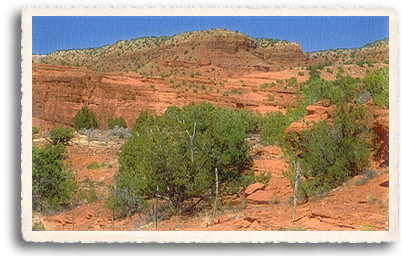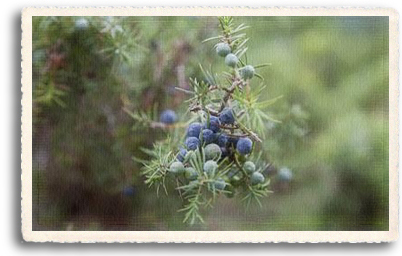 |
||
Juniper Trees in the Northern New Mexico High Desert  Juniper is a coniferous plant of the cypress family, with more than 50 varieties ranging all the way from the arctic to tropical Africa. This 25 to 50 foot tree is common in the Southwest, where it causes severe allergic reactions in much of the population during late winter and early spring when it is in flower. Juniper berries are actually a modified pine cone, with fleshy scales that merge together to form an outer skin over the seed, giving it a berry-like appearance. The berries start out green, ripening into a blue, purple or nearly black color in 10-18 months, depending on the variety. Trees will typically contain berries at all stages of the ripening process. Juniper is a coniferous plant of the cypress family, with more than 50 varieties ranging all the way from the arctic to tropical Africa. This 25 to 50 foot tree is common in the Southwest, where it causes severe allergic reactions in much of the population during late winter and early spring when it is in flower. Juniper berries are actually a modified pine cone, with fleshy scales that merge together to form an outer skin over the seed, giving it a berry-like appearance. The berries start out green, ripening into a blue, purple or nearly black color in 10-18 months, depending on the variety. Trees will typically contain berries at all stages of the ripening process.While highly toxic, juniper berries are used for medicinal purposes, in cooking and for other flavorings. Perhaps the best known use of these highly aromatic berries is the use of green berries in the flavoring of gin, which explains the particularly bad hangover that overindulgence in gin produces. In addition, the beautiful ripe blue to purple-black berries are used in numerous culinary applications, including a sauce for game meats, such as quail, pheasant, rabbit, boar and venison. Juniper berries are typically used in Norwegian and Swedish dishes, and sometimes in German, Austrian, Czech and Hungarian cuisine, often to flavor roasts. Northern Italian cuisine sometimes incorporates juniper berries. I have even made a tofu dish flavored with juniper berries which tasted very much like duck. While thought of mostly as a flavoring for the game meats and fowl, juniper berries also complement pork and beef dishes. Their pungent, piney flavor is particularly suited to marinades and sauces with black pepper, garlic, sage, thyme or rosemary.  Juniper berries have diuretic, anti-inflammatory and antiseptic properties, and are used medicinally to treat a wide range of ailments, including asthma, arthritis, rheumatism, and to hasten childbirth. An infusion of juniper berries can be used as a topical antiseptic to treat wounds, acne and other skin disorders, including growths. The antiseptic action of juniper moves through the body, disinfecting the digestive system, relieving ulcers, colitis and urinary infections. It also removes uric acid from the body, relieving gout and kidney disease. High in natural insulin, juniper was used by certain Indian tribes to treat diabetes, as a contraceptive, and as an appetite suppressant in times of hunger or famine. A folk tale reported in Rodale's Illustrated Encyclopedia of Herbs mentions more esoteric uses for juniper: "The plant's pungent aroma has long recommended it for driving away evil spirits and disease. Legend has it that juniper planted beside the front door will keep out witches; the only way for a witch to get past the plant was by correctly counting its needles." Juniper is durable, adaptable and tolerates extremes of both heat and cold, making it a commonly used element in landscaping. This versatile plant includes tall tree, bushy and creeping ground cover varieties. The trees are also some of the most popular species chosen for bonsai. With the exception of a few juniper species, specimens have two types of leaves. Seedlings and occasional twigs of mature trees have needle-like leaves, while the mature plants produce tiny, overlapping, scaly leaves. Several species of butterfly larvae feed exclusively on juniper, including the Juniper Carpet, Juniper Pug and Pine Beauty. Back to Plants & Wildlife |
||
Home | Food | Lodging | Merchants | Services | Real Estate | Art & Galleries | Entertainment | Recreation Ski Areas | Mind-Body-Spirit | Taos Information | Local Color | Taos Pueblo | High Road to Taos | Taos Plaza | Ranchos de Taos Scenic Beauty | Day Trips | Chili | Special Events | Taos History | Multicultures | Museums | The Enchanted Circle The Wild West | Taos Art Colony | Plants & Wildlife | Counterculture | Turquoise | Architecture | Features | About Us |Get Listed! Taos Unlimited Trading Post | Photo of the Week | Link of the Month | Taos Webcams |Taos Weather | Testimonials | Guestbook Taos A to Z | Movie Locations |Sitemap | Taos Unlimited Blog | Aimee & Jean's Story Blog | Contact Us | Santa Fe Unlimited |
||